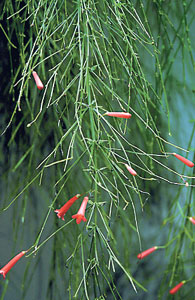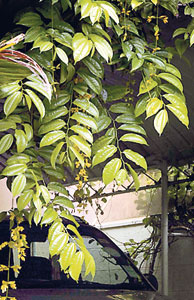Locating the plants correctly in your garden is as equally important as having the plants. Would you go for foliage plants or flowering plants? My choice is an admixture of both that adds colour and variety to your garden.
Take these facts into account before deciding on where you want a particular plant. Does the plant need shade, semi-shade or direct sun? Is it a ‘ground hugger’, ‘creeper’, ‘dangler’, epiphyte, bush or a tree? Is it self-maintaining or does it require regular nursing?
Is it a plant you would like to see from the main doorway of the house? Do you want it to invigorate the air with scent? Is it an exotic plant you want to show off? How large does the root system grow? Consider these aspects one by one.
There is no set way of garden landscaping. Your garden should be done to your liking, no one else can create its appeal for you. Textbooks and well landscaped gardens should make you think and not copy!
Plants - two types
Home garden plants are usually of types. Those planted directly on the ground and those in pots or attached to supports. Either can be shifted around to change the look of your garden. But, plants growing on the ground are best not uprooted at will for it can cause growth retardation or even the loss of a prized plant. When the need arises uproot them carefully and replant elsewhere. Nowadays, the technique of ‘root-balling’ is available to shift around even huge plants such as fully grown palms. This calls for expertise.
The notion is therefore to have a blend of ground plants and pot plants. Ground plants are for character and pot plants are to allow a change.
Flowering plants
Flowering plants like Zinnias and barberton daisies grown in clusters in flower beds are eye-catching. Zinnias being perennials need nursing and periodic replacement.
‘Ground huggers’ to sun lovers
‘Ground huggers’ are best planted in the moist, cool - shade at the edge of the garden. They grow clustered, and spread out matted. These are best grown abutting the plinth / pavement of the building. Grown close to the house, these prevent splashing of mud and dirt and prevent discolouration of the base of walls.
Such plants - Selaginella (non-flowering) and Episcia (red flower), Peperomia (bushy with horn-shaped flower) and Pilea (foliage) need very little attention apart from trimming.
Caladiums (multicoloured foliage plants) require semi-shade and ought not to be tucked away in a corner. Place these in eye-catching places. A walk way lined with potted caladiums is a novel display.
Palms in pots or on the ground tolerate bright sun. If grown in the ground, they are best located at the edges of the garden. These grow bushy or as tall trees and some bear colourful berries that when ripe attract birds and squirrels.
It is important to select the plant according to the intensity of sunlight it requires. A plant needing shade can get scorched if exposed to bright sun. So choose the right spot in the garden for the appropriate plant.
Creepers up - ‘Danglers’ down
Creepers need supports like a trellis or other trees. Small creepers can be grown in pots and placed against trelliswork. An attractive, yet hardy creeper is Hoya. The Hoya bella creeper can be trained to follow any zigzag trellis or loop. It has a bunch of attractive candle wax flowers, that last many days.
Modern house designs often have carports and a creeper like Bahunia cocknia or ‘Golden Bells’ trained to climb up to the carport roof and dangle down will protect the car from sun, rain and dust. Its colourful inflorescences welcome you to your outward car journey as much as welcoming you back home.
Danglers like Epipremnum, Hedera, and Sedum which have attractive foliage need pots. The pots can be kept as outdoor window-boxes or can be kept at elevations (tied to tree trunks, nailed to perimeter walls) in semi-shady spots scattered in the garden.
Orchids and tree ferns are epiphytes. Epiphytes grow attached to tree trunks (eg. Mango tree). There are many varieties of orchids to select from -Dendrobiums, Vandas, Ascocendas, Cattleyas, Phalaenopsis.
A small garden can even have a tiny rockery located at a sunny spot if cacti are to be planted. A rockery with cacti is best located at the edge of the garden, away from the reach of kids and somewhat elevated like an anthill.
Tree ferns are attractive epiphytic plants that have very attractive leaf forms. Varieties of Nephrolepis can be grown stuck to tree trunks. Or a shady rockery can be created with ferns attached to decayed logs held between boulders. Platycerium is an attractive fern that can be stuck on to a tree trunk or attached to an earthenware pot hanging from a tree.
Remember to include one or two flowers with scent in your garden. Indigenous to Sri Lanka are the bushy plants Gardenia, Jasmine and Night Jessamine that can be grown easily.
Exotic plants
Nolina is an exotic plant. Its life can begin in a pot. When grown to a height it can be transferred to ground. It gives an exotic feminine touch that many visitors to your home enquire about!
|



